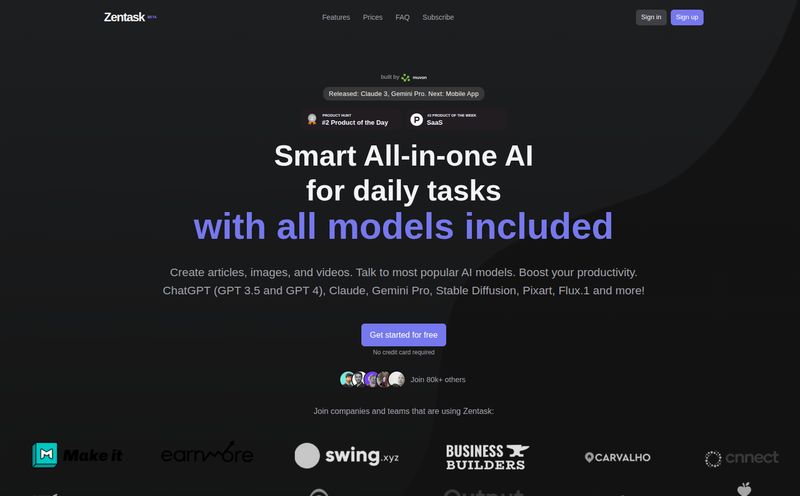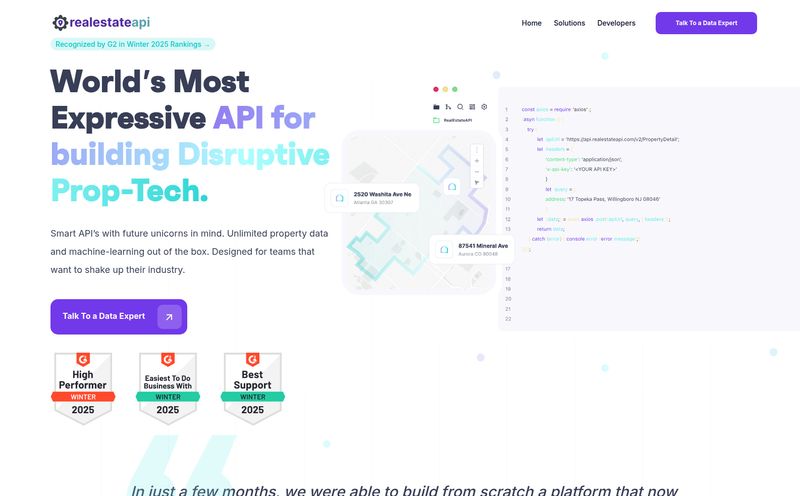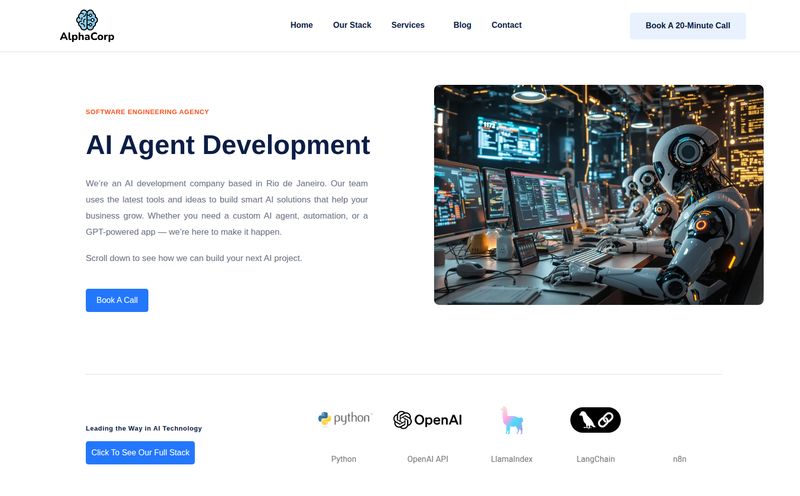Nobody gets into software development because they're passionate about writing boilerplate regression tests. It’s the necessary chore, the digital equivalent of eating your vegetables before you can have dessert. For years, the cycle has been the same: build cool stuff, then hand it over to the Quality Assurance team, creating a bottleneck that can slow a sprint to a crawl. We've tried to speed it up with automation frameworks like Selenium, but that just shifts the burden—now developers or specialized engineers have to write and maintain mountains of test code. It's a traffic jam on the highway to production.
But what if that's starting to change? I’ve been keeping a close eye on the AI explosion, not just in content and image generation, but deep in the guts of the software development lifecycle (SDLC). And I stumbled upon a tool called TestSprite that made me lean in a little closer. It’s not just another test runner. It claims to be an AI-powered platform that handles the entire end-to-end testing process. The whole shebang. That’s a big claim, and as someone who’s seen a lot of tech fads come and go, I’m naturally skeptical. But I’m also intrigued.
So, What on Earth is TestSprite?
In simple terms, TestSprite is an AI that acts like a super-diligent QA engineer. You give it some basic information about your application, and it takes over from there. And when I say takes over, I mean it. The platform is designed to build the test plan, write the actual test code, run the tests, find the bugs, and then spit out a report telling you what broke. All with what they claim is “minimal input” from your team.
Think about that. The traditional process involves a product manager writing a spec, a developer building the feature, a QA analyst writing a test plan in Gherkin or some other format, and then a QA engineer (or the dev) writing the code to automate that test. TestSprite aims to short-circuit that entire chain. It’s less of a tool and more of an autonomous agent for quality control. A wild idea, but one whose time has probably come.
How TestSprite Is Shaking Up the QA Game
Okay, the high-level pitch sounds great. But as we all know, the devil is in the details. How does it actually work? It seems to boil down to a few core capabilities that directly address some of the most annoying parts of software testing.
From Test Plans to Executed Code, Automatically
This is the part that really caught my attention. The idea that an AI can analyze an application and generate a logical test plan is… well, its a game-changer if it works. It's supposed to understand user flows and edge cases on its own. Then it writes the code to test them. This could potentially save hundreds of hours of manual work, freeing up your team to focus on building new features instead of just protecting old ones. It’s like having a junior dev who does nothing but write tests, 24/7, without complaining.
The “Self-Serve” Testing Dream for Developers
One of the biggest pushes in modern software development is the idea of empowering developers. In a CI/CD (Continuous Integration/Continuous Deployment) world, developers are expected to own their code from creation to deployment. TestSprite fits right into this philosophy. It offers a self-serve model where a developer can just point the AI at their new feature and get a full test suite back. No more waiting for another team. No more context switching. This could dramatically speed up release cycles and make agile development actually agile.
Comprehensive Reporting Without the Busywork
If you've ever had to manually compile a bug report, you know the pain. Screenshots, console logs, replication steps… it's tedious. TestSprite automates this, providing reports that show exactly what went wrong and where. This means less time trying to figure out if it’s a real bug or a flaky test, and more time actually fixing the problem.
The Good, The Bad, and The AI-Powered Reality
No tool is perfect, right? Especially one that’s on the cutting edge. So let's talk about the real-world pros and cons. Based on what I've seen, the advantages are pretty clear. You’re looking at a serious reduction in the time and money spent on QA. That’s not just about salaries; it’s about the opportunity cost of having your most expensive engineers bogged down in maintenance tasks. The minimal input required is also a huge plus. It means your team can stay focused. And having comprehensive end-to-end coverage gives you the confidence to ship code faster. Your CFO and your product manager will probably both love that.
Visit TestSprite
However, let’s ground ourselves in reality. A major point to consider is the reliance on AI. Personally, I'm not quite ready to let an algorithm sign off on a major release without a human double-checking its work. The results will need validation, especially in the beginning. You have to treat the AI as a very smart, very fast assistant, not an infallible oracle. You still need human oversight and expertise to review the tests it generates and interpret the results. There’s also the matter of initial setup. You can't just press a button and have it work magically. Like any powerful platform, it will require some configuration and integration into your existing workflow. There's no magic wand for that.
What About the Price Tag?
This is the million-dollar question, isn't it? Or, hopefully, a lot less. As of now, TestSprite hasn’t published its pricing. This is pretty standard for enterprise-grade B2B tools. Pricing is often tailored based on the size of your team, the number of tests you run, or the specific features you need. So, you’ll have to get in touch with them for a demo and a custom quote. My advice? Don't be shy. The goal is to figure out the potential return on investment. If it can save a few hundred developer hours a year, it could pay for itself very quickly.
Who is TestSprite Really For?
I see a few groups getting really excited about this. First, software development managers who are constantly trying to unblock their teams and ship faster. This could be their secret weapon. Second, fast-moving startups and scale-ups that need robust testing but can't afford to build a massive, dedicated QA department from scratch. This gives them enterprise-level capabilities on a leaner budget. And finally, any company embracing a DevOps culture that wants to push testing further “left” — that is, earlier in the development process.
It’s part of a larger movement. We’re seeing AI creep into every corner of the developer's world, from tools like GitHub Copilot that help write code to platforms like TestSprite that help test it. The future of software development isn’t about replacing humans. It’s about augmenting them. It’s about automating the repetitive, predictable work so that humans can focus on the hard stuff: architecture, user experience, and creative problem-solving.
Your Questions, Answered
I've gotten a few DMs about this, so let's run through a quick FAQ.
- Is TestSprite a replacement for human QA testers?
- Absolutely not. It's a force multiplier. It handles the boring, repetitive regression testing, freeing up human testers to perform more valuable exploratory testing, usability testing, and to apply their critical thinking to complex scenarios the AI might miss.
- How much technical skill is needed to use TestSprite?
- While there's an initial setup, it’s designed to be a self-serve tool for developers. The whole point is to reduce the specialized knowledge needed to create and maintain a full test suite. You don't need to be a Selenium wizard to get it working.
- What kind of applications can TestSprite test?
- It's positioned for general software development, which typically means web applications are its bread and butter. For specifics on your particular tech stack—like mobile, desktop, or specific frameworks—your best bet is to check with their team during a demo.
- How does this compare to tools like Selenium or Cypress?
- It's a different level of abstraction. Selenium and Cypress are frameworks—they give you the building blocks to write tests. TestSprite is a platform that uses AI to do the writing for you. It operates a layer above those tools.
- Is there a free trial for TestSprite?
- The website doesn't explicitly mention a free trial. In the B2B SaaS world, the standard path is to request a personalized demo to see if the tool is a good fit first. That's likely the best way to get your hands on it.
So, Should You Give TestSprite a Shot?
Look, the QA bottleneck is real. I’ve seen it cripple projects and burn out good people. Any tool that credibly offers a way out of that cycle is worth investigating. TestSprite is ambitious, and frankly, I'm excited by its promise. It represents a shift from manual automation to intelligent automation.
Will it solve all your problems overnight? No. You’ll still need smart engineers and a solid testing strategy. But could it eliminate a huge chunk of the most tedious work your team faces? It seems very possible. And for that reason alone, I think it's worth starting a conversation. The less time we all spend on soul-crushing, repetitive tasks, the more time we have to build the future. And that’s a win for everybody.
Reference and Sources
- TestSprite Official Website (Assumed): https://www.testsprite.ai
- Atlassian on CI/CD: Continuous integration vs. continuous delivery vs. continuous deployment
- GitHub Copilot: Your AI pair programmer



